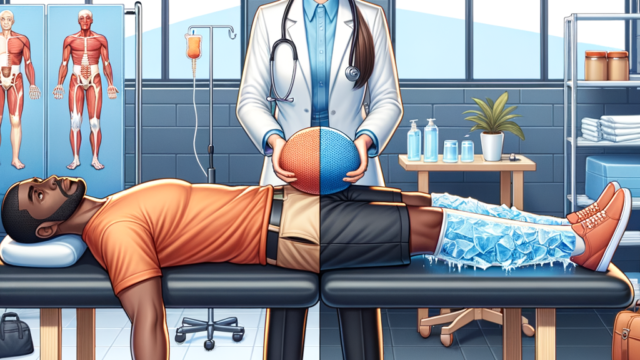Hot-cold therapy, also known as contrast therapy, is a popular method used to promote overall wellness and alleviate various health issues. This article delves into the scientific intricacies of hot-cold therapy, exploring the physiological processes and the multifaceted benefits it offers.
The Effect on Blood Circulation

Hot-cold therapy’s profound influence on blood circulation is rooted in its ability to manipulate blood vessel responses. Exposure to cold temperatures causes vasoconstriction, leading to a reduction in inflammation and swelling in the targeted areas. Conversely, the application of heat induces vasodilation, thereby enhancing blood flow to the treated region.
Hot-cold therapy’s impact on blood circulation is nothing short of remarkable. The alternation between hot and cold stimuli stimulates the circulatory system, which can result in improved nutrient delivery and waste removal from tissues.
Muscle Recovery and Inflammation

Hot-cold therapy plays a pivotal role in expediting muscle recovery and mitigating inflammation. Intense physical activity often leads to muscle soreness, characterized by micro-tears and localized inflammation. Here’s how hot-cold therapy works its magic:
- Cold therapy immediately reduces inflammation by constraining blood vessels, effectively calming the affected area.
- Heat therapy, on the other hand, promotes muscle relaxation and tissue flexibility, fostering greater mobility and recovery.
The combination of these contrasting temperature treatments can significantly accelerate the healing process for sore muscles and injuries.
Types of Hot-Cold Therapy
Hot cold therapy comes in several forms, each tailored to meet specific needs and preferences.
Ice Baths
Ice baths involve submerging the body in cold water or sitting in a tub filled with ice cubes. This method is particularly favored by athletes looking to expedite their post-workout recovery. The shock of cold immersion is believed to constrict blood vessels, reducing muscle inflammation and soreness.
Heating Pads
For localized treatment, heating pads are a convenient option. They provide a consistent source of heat, making them ideal for addressing muscle pain, stiffness, and discomfort. Heating pads offer a soothing and targeted approach to hot-cold therapy.
Contrast Showers
Contrast showers are another intriguing method. They alternate between hot and cold water, providing an invigorating experience. This variation in temperature encourages improved circulation, helping to rejuvenate the body and mind. Contrast showers are a practical way to incorporate hot-cold therapy into daily routines.
Benefits of Hot-Cold Therapy
The benefits of hot-cold therapy extend far beyond just muscle recovery, making it a holistic wellness approach.
Pain Relief
Hot-cold therapy is a potent tool for pain relief. It can effectively alleviate chronic pain, tension headaches, and even menstrual cramps. By enhancing blood flow and relaxing tense muscles, hot-cold therapy provides a natural and drug-free pain management solution.
Faster Recovery from Exercise
Athletes and fitness enthusiasts often turn to hot-cold therapy to expedite their recovery process. The alternating temperatures aid in repairing and strengthening muscles, allowing individuals to bounce back more swiftly from intense workouts.
Stress Reduction
The relaxation induced by heat therapy can significantly reduce stress and anxiety. It has a calming effect on the nervous system, promoting a sense of overall well-being. Incorporating hot-cold therapy into your routine can be a valuable stress management strategy.
How to Safely Administer Hot-Cold Therapy
While hot-cold therapy offers numerous advantages, it’s essential to adhere to safety guidelines to ensure both efficacy and safety.
Precautions and Guidelines
To maximize the benefits and minimize risks, it’s crucial to avoid extreme temperatures when applying hot-cold therapy. Never place ice or heat directly on the skin without using a protective barrier. Consulting a healthcare professional before embarking on a hot-cold therapy regimen is advisable, particularly if you have underlying health conditions.
Duration and Frequency
The duration and frequency of hot-cold therapy sessions can vary depending on individual needs. Generally, a typical session lasts between 15 to 20 minutes, with alternating hot and cold phases. It’s essential to listen to your body and adjust accordingly.
Hot-Cold Therapy for Specific Conditions
Hot-cold therapy can be tailored to address specific health conditions, offering relief for a variety of issues.
Arthritis
Hot-cold therapy can provide significant relief for individuals suffering from arthritis. By reducing joint pain and stiffness, it enhances the quality of life for those managing this chronic condition.
Sports Injuries
Athletes often utilize contrast therapy to recover from sports-related injuries, such as sprains and strains. The combination of hot and cold treatments helps reduce inflammation and promotes quicker healing.
Muscle Strains
For those dealing with muscle strains, hot-cold therapy can be a valuable component of the rehabilitation process. The alternating temperatures aid in relieving pain and expediting the healing process.
Comparing Hot-Cold Therapy to Other Treatments
It’s essential to understand how hot-cold therapy measures up against alternative treatments.
Medications
While medications can provide temporary relief, they often come with side effects. Hot-cold therapy offers a drug-free alternative, reducing the need for pharmaceutical interventions. It focuses on addressing the root cause of discomfort rather than masking symptoms.
Physical Therapy
Hot-cold therapy can complement physical therapy sessions effectively. By incorporating contrast therapy into rehabilitation programs, patients may experience faster progress and improved outcomes.
Conclusion
In conclusion, hot-cold therapy offers much more than a fleeting sensation of comfort; it is firmly rooted in science. Understanding how it modulates blood circulation, facilitates muscle recovery, and delivers a myriad of health benefits empowers individuals to embrace it as a holistic wellness practice. Prioritizing safety and seeking professional guidance when necessary are vital aspects of integrating hot-cold therapy into your life. Embrace this natural, drug-free approach to enhance your well-being and alleviate discomfort.
